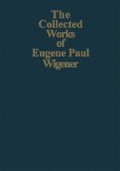Summary
The significance of the energy-momentum conservation laws, as consequences of the general invariance principles, is much enhanced if the momentum, and hence the energy, can be coupled, still by means of the invariance principles, to some directly observable quantity. If the positions of particles can be measured in the quantum-mechanical sense, and if the corresponding operator satisfies the obvious invariance requirements, the velocity can also be ascertained and its relation to the momentum four-vector can easily be derived from the displacement invariances. Serious doubts have been cast, however, on the measurability of the position. Hence, a more primitive method of measuring the velocity, by means of « traps » is described; it is essentially the experimental method. The connection between momentum and velocity is then derived, for the velocity measured in this way, from the displacement invariance principle.
Access this chapter
Tax calculation will be finalised at checkout
Purchases are for personal use only
Preview
Unable to display preview. Download preview PDF.
Reference
See, for instance, a) E. WIGNER: Gruppentheorie und ihre Anwendung auf die Quantenmechanik der Atomspektren (Braunschweig, 1931); or b) a somewhat extended English translation by J. J. GRIFFIN (New York, N. Y., 1959); or e) M. HAMERMESH: Group Theory and its Application to Physical Problems (Reading, Mass., 1962).
A determination of some of the properties of the stationary states (Chap. 19 of ref. (lb)) falls into this category. So does the solution of problems such as the probability of a certain component of the angular momentum if the component in another direction is given.
The later, more explicit and sophisticated articles of F. ENGEL (Nachr. Akad. TViss. Gòttingen Math. Phys. El., (1916), p. 270) and of E. NOETHER (Nachr. Akad. Wiss. Gottingen Math. Phys. El., (1918), P. 235) are more often quoted. For the history of the subject, see P. HAVAS’ article (Acta Phys. Austriaca, 38, 145 (1973)) and F. KLEIN’S book Vorlesungen über die Entwicklung der Mathematik im 19 Jahrhundert (Berlin, 1927) quoted therein.
Inaccuracies of these symmetries were suggested to T. D. LEE and C. N. YANG by some puzzling phenomena in particle physics and first proved by Wu, AMBLER,HOPPES and HUDSON. See the Nobel lectures of C. N. YANG and of T. D. LEE, reprinted in Science, 127, 565, 569 (1958). Another departure from a reflection symmetry was proved by J. H. CHRISTENSON, J. W. CRONIN, V. L. PITCH and R. TURLAY. See Phys. Rev.. 140, B 74 (1965) and many later publications based thereon.
An indication in this direction is contained already in W. PAULI’S article Die allgemeinen Prinzipien der Quantenmechanik in Geiger-Scheel Handbuch der Physik, Vol. 24 (Berlin, 1933 ), p. 91.
Naturally, the momentum can be measured also by other means, in particular in the case of charged particles by means of electromagnetic fields. The reaction of particles to such fields can, however, not be deduced from invariance principles.
By this we mean h/mc 2.
Cf. E. WIGNEE: Ann. of Math., 40, 149 (1939); V. BARGMANN and E. P. WIGNER: Proc. Nat. Acad. Sci., 34, 211 (1948). We use the results and the notations of these articles.
See F. E. GOLDRICH and E. P. WIGNER: chapter in Magic Without Magic, edited by J. IKLAUDER (San Francisco, Cal.. 1972), p. 147. Actually the trap will not act instantaneously; its operation will require some time. However, this does not alter our argument except that a) t must denote the center of the time interval of the operation of the trap and b) the duration of the operation of the trap must be very short as compared with the time t elapsed before the trap is operated.
Editor information
Editors and Affiliations
Rights and permissions
Copyright information
© 1997 Springer-Verlag Berlin Heidelberg
About this chapter
Cite this chapter
Ahmad, S.M.W., Wigner, E.P. (1997). Invariant Theoretic Derivation of the Connection Between Momentum and Velocity. In: Wightman, A.S. (eds) Part I: Particles and Fields. Part II: Foundations of Quantum Mechanics. The Scientific Papers, vol A / 3. Springer, Berlin, Heidelberg. https://doi.org/10.1007/978-3-662-09203-3_29
Download citation
DOI: https://doi.org/10.1007/978-3-662-09203-3_29
Publisher Name: Springer, Berlin, Heidelberg
Print ISBN: 978-3-642-08179-8
Online ISBN: 978-3-662-09203-3
eBook Packages: Springer Book Archive

